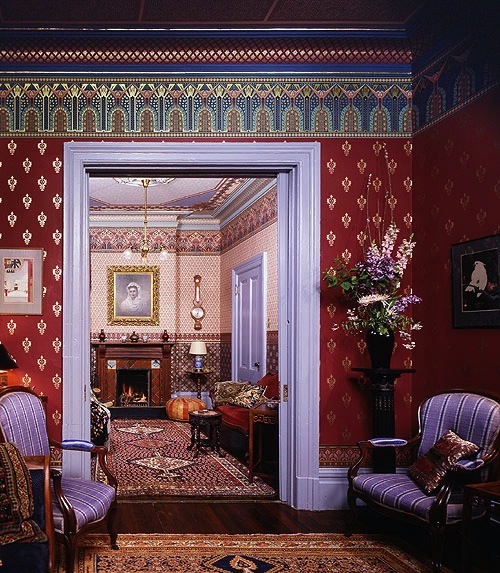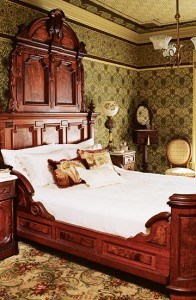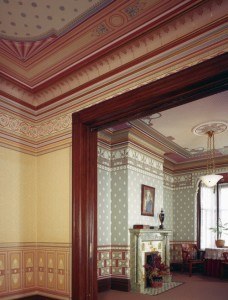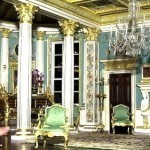
Christopher Dresser’s (1834-1904) Roland Wall, in terracotta and burgundy, with a Victory frieze in indigo.
What Is The “Right” Kind Of Victorian Wallpaper?
The answer could start with another question. “That depends. Which room? Town or country house?” When choosing the appropriate type of wallpaper for a Victorian dollhouse, it’s important to understand how wall coverings were used in the Victorian era.
Wallpaper became an important element to the interior decoration in the Victorian era as it became accessible to the middle-class householders. Two events brought this about: the introduction of mass production techniques brought down the prices; the repeal of the wallpaper tax in 1836.
Popular Wallpapers
Popular wallpapers in the early and mid-Victorian period had backgrounds of red, blue, and green printed with intricate scrolled floral patterns in shades of cream and tan. Later, rich earthy tones with stylized plants became common. Embossed paper was used on ceilings and friezes to counterbalance the busy patterns on the wall.
William Morris was the most well-known designer of a wallpaper at the time. He was renowned for mixing strong, pure colors harmoniously, and giving a flat pattern a narrative quality. Other popular designs included landscape pictures, historical scenes, and papers imitating cut stone or fabric. Panels known as ‘frescoes” imitated cornices, friezes, moldings, and columns were popular. The 1870s saw the emergence of geometric patterns and Japanese motifs.

William Morris style St. James, a 17-color damask was originally designed at twice this scale for Queen Victoria’s Throne Room at St. James’s Palace in 1881.
With the introduction of the dado (chair) rails and picture rails to divide the vertical space of walls was deemed to be the epitome of artistic taste. Wallpapers came to be produced in sets of three: one for cornice to the picture rail; one for picture rail down to the dado rail; the last from under the dado rail to the baseboard.
Industrial Revolution
The Industrial Revolution had a dramatic impact on interior design in the Victorian Age. The prosperity of the middle class increased and allowed them, along with other new opportunities, the chance to change the decoration and ornamentation of their homes.
The pollution generated by all those prosperous factories also influenced interior design. City dwellers tended to paint their walls more than their country cousins, who could also use lighter tones. Pollution also dictated how often one could change their décor. Aristocrats were not affected; they could afford to change wallcoverings at will. The lower orders might have to put up with sooty walls longer than what was considered fashionable.
Nouveau Riche In A Quandary
Some of the newly wealthy, unsure of how to best portray their sudden status and wealth, chose architecture and furnishings previously used only by the upper class. In these homes, the owners crammed in as many pieces of furniture, fabrics, and knickknacks as possible, in an effort to flaunt their new status. Also, it was fashionable to believe that bareness in a room was a sure sign of poor taste.
End Of The Victorian Era
It is seldom that an era as a definite end, but we know exactly when and where the Victorian era ended. It was on January 22, 1901, at Osborne House, East Cowes on the Isle of Wight, directly across the Solent from Southhampton. That’s the day and place Queen Victoria died. The Edwardian Era began the next day when Victoria’s son Bertie became heir to the throne. It would become official the following August when Bertie was coronated Edward VII.
This bit about royal succession is only important to dollhouse miniaturist because many think the Edwardian era is just a continuation of the Victorian. Not true. The exteriors of Edwardian buildings had less ornamentation the Victorian, but interior décor went wild. A generalization would be that any kind of ornamentation was acceptable as long as the color and shape fit in with the surroundings. Also, the color schemes tended to be lighter in tone than the Victorian.
After you have decided on the era, and who the householder might be, the answer to “what is the right wallpaper for my Victorian dollhouse“ might be: how vivid is your imagination?
The pictures of wallpaper in this article are from Bradbury&Bradbury, a company that sells real wall coverings of authentic period designs. It’s a wonderful resource for miniaturists to research ideas.
Susan Downing, with Patrick Owens







